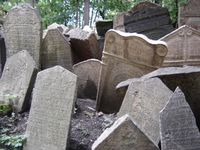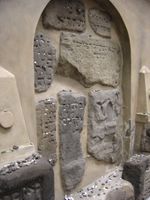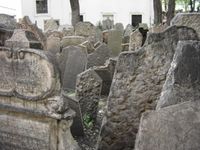We started our day at the breakfast buffet downstairs, which was slim pickin’s by the time we got there, and Chris dropped off some shirts he’d laundered to be ironed (there are no irons in the rooms, and the hotel said they didn’t have any to loan – they just send them out). We were both feeling better, but still a little tentative.
The Jewish Quarter, the sites now combined into something called the "Jewish Museum," isn’t far from the hotel, so we began our tour at the Maisel Synagogue (as per Rick Steves’ instructions). The entry fee was high enough that we didn’t have enough cash to purchase entry to everything (only the Old-New Synagogue was left out), and they didn’t take credit cards. So, we toured the sites we could on the ticket we bought – the Maisel, Spanish, Pinkas and Klaus Synagogues, the Ceremonial Hall, and Old Cemetery.
Through the Maisel and Spanish Synagogues was a running exhibit of Jews through Czech history, which was really interesting. The Pinkas Synagogue has a rather modern exhibit, where the names of the 80,000 Czech Jews killed during the Holocaust are written on the walls. Upstairs in the Pinkas Synagogue is an exhibit of some of the art created by children who passed through the Terezín Concentration Camp outside Prague. The Ceremonial Hall has exhibits on Jewish burial customs, and the Klaus Synagogue has exhibits on Jewish home life and the Jewish calendar. All of the sites had various artifacts, religious and otherwise, dating back hundreds of years and showing the rich cultural history of the Jews of Prague. It’s sad to note that throughout history, the Jews have been persecuted as scapegoats for any of a city’s or country’s problems, and alternately been some of the most learned and respected members of a society. It always seems that when things are going really well for the Jews, that’s when things begin to go very wrong – almost as if someone thinks they’ve got it too good, that they have taken something away from the non-Jewish people. The Nazis weren’t the first to force Jews to wear a badge or some other garment to label them, that’s for sure.
In the Spanish Synagogue I found the names of two deportees from Terezín to Auschwitz and Birkenau with my last name. And in the Pinkas Synagogue I found more of my name written on the walls. I doubt that they’re relatives in the immediate sense of the word, but it’s still eerie to see my name among the dead of the Holocaust. It makes me more certain that it would be a small miracle, indeed, if none of my family perished during those terrible years.
The Old Cemetery is just as chaotic and wonderful as I remember it from 13 years ago, though it seems much more organized and roped-off than before. There’s a prescribed path leading from the Pinkas Synagogue through the Cemetery in one direction, with many branches off the main path which are roped or fenced off.


The Old Jewish Cemetery is a tumbled mass of gravestones toppling over one another, propping each other up. Jewish law dictates that a body not be moved after burial, and the Jews were granted no more than the land they had for their cemetery - so they just went up, and their gravestones went up with them. People are buried three and four deep. No one has been buried here for ages - there's a new Jewish cemetery outside of the city (where Franz Kafka is buried). You can see in the left photo that they are currently attempting some restoration work on some of the gravesteones - the ones they're working on are covered in plastic.


The pieces of the gravestones in the right picture are the oldest in the cemetery - they were moved at some point, obviously, and they are now in a special area along one wall. You'll notice the pebbles and small pieces of note paper on these graves - there are small stones on graves throughout the cemetery. It's a Jewish tradition that stones, instead of flowers, are left on graves.


Being surrounded by all those artifacts and years of Jewish history, I couldn't help feeling like a part of something larger - even though I'm not Czech. And then, of course, seeing my name in those displays gave me both a sense of place and completely unnerved me.
After our tours (and a stop at the gift shop), we set off in search of a bank machine, since the entry fee we’d paid that morning had tapped our cash supply. One after another, however, the bank machines we tried all told us that they were unable to complete our request. We tried both of our cards, and many different banks. We were using machines that not only had Visa logos on them, but also had the “Plus” logo on them (which our cards have on the back), so we were really confused about what was wrong. After five or six refusals, we decided to go back to the hotel and get online to see if we could get some answers.
Upon arriving back at the hotel we were told Chris’ ironing was done and back in his room, and that it would cost 600 Kč – in cash, of course, which we didn’t have. We told the gal at the reception desk that we were attempting to get money, and we’d have to get back to her.
More frustration – the dial-up, frustratingly slow when we used it before and therefore nothing to write home about – wasn’t even working this time. Chris finally just called his bank to make sure there wasn’t anything wrong with his card. They assured him there was no problem, said that they often had trouble with the “Plus” machines in this area, and gave us a couple other logos to look for. We also read in the R.S. book that there were American Express offices scattered around the city, which we figured we could take advantage of in a pinch using Chris’ work AmEx. So, we headed back out again.
The AmEx offices that were supposedly close to us were either no longer in existence or we were unable to locate them (despite asking several people), so we hoofed it over to the Wenceslas Square office, checking bank machine logos all along the way. Finally at the AmEx office, Chris was told immediately that they don’t do cash advances on AmEx cards, that it wasn’t technically an AmEx office but rather an “InterChange” office. (Which explains the giant “American Express” logo outside, right?) Frustrated, tired, and running out of options, we hit an Internet café on the way back to see where we might find banks with some of the other logos we were looking for. We found the website we wanted, but unfortunately the list gave us hundreds of bank locations of a bank we’d already tried several times with no luck.
Prague was rapidly becoming more of a problem than anything else.
The tourist information office beneath the clock tower in the Old Town Square was no help at all – the woman didn’t understand the words “cash advance.” I’m the first person to decry the fact that Americans don’t speak other languages, and that’s really arrogant of us, but if someone works in a tourist information office I’d expect them to speak English pretty well. But perhaps that was the frustration talking.
We eventually walked back to a place Chris had seen earlier where they would do a cash advance on a Visa card for a fee. It wasn’t the best solution, but it was one of the last options we had at our disposal (the last being to exchange what little money we had in Euros). We came back to the hotel and paid the ironing bill (which, by the way, is pretty exorbitant – roughly $30 for ironing 6 shirts?!?), and then spent some time recovering from the ordeal.
I wanted to get back to the place I was in the morning, when I was completely charmed by just looking at the city, just walking around. There were sights we still wanted to see, including the Old-New Synagogue, the Castle and the Cathedral. And there was a potential day-trip to Kutná Hora to consider. These things would all take money, and we hoped they would take credit cards – not just for the ease of use, but now for the necessity. Cash, more than anything else in town, seemed to be the hardest thing to come by.
After a little time cooling off in the room, we eventually headed back out to walk around a bit and get dinner. We walked back to a shoe shop Chris had been eyeing earlier, and though the shoes were nice and he’d have happily added several pairs to his shoe collection at home, at roughly $130 a pair (on sale!) they were a bit steep for his taste. We browsed the semi-permanent vendor stalls in the Old Town Square – the area that, 13 years ago, was occupied by people selling only what they themselves had made from crudely set up folding tables. Now, every other shop is selling the same T-shirts and key chains. We had two days left here, and we planned to look for gift items for a few people and maybe shop for ourselves as well, but it was a different shopping experience now than it was when my cousin and I waited patiently as the woman outside the Jewish Cemetery painted my name and “Praha” on the backside of a small river stone on which she’d already painted a Star of David. With all the assembly-line trinkets available nowadays, there’s sadly no room for that woman anymore.
Over dinner that night, we ended up talking about the day’s frustrations, and came to some conclusions. Chris said he feels like there’s an edginess about Prague, something slightly unsettled. I agreed – much of the guidebook is written in such a way that indicates while it’s a friendly city to visit, tourists should be wary of the relatively few scams left from the pre-tourist days. When I was here in 1992, it was so far from being a tourist destination (especially compared to now) that we weren’t expecting things to be easy. No one spoke English, and I had my cousin to help me navigate – not only does she speak German (which, at the time, was the only other language anyone knew – if they knew another language at all), but back then she was also “dabbling” in Slavic languages and actually wanted to test her Czech. I didn’t have to converse with anyone.
That was also the days before the ubiquitous ATM machine, which makes travel in every Western European country a breeze – travelers cheques are a thing of the past for us. In 1992, that was all I had coming over to Europe, and while I’m sure the exchange booths were as much of a rip off then as they are today, they were (and still are) everywhere so exchanging money was no problem at all. There weren’t restaurant hawkers pushing menus in your face every few minutes, trying to get you to sit down for a meal at their establishment. And there weren’t tour groups, led by people carrying huge and colorful umbrellas over their heads to be seen by the crowds of 30-40 who follow them around, clogging the small cobbled streets and the even smaller hallways of the indoor sights. In short, in 1992 it was a city that wasn’t catering to tourists in the way that Paris or Venice has been doing for centuries.
Now, the city looks like any other Western European city – on the surface. Taxis are everywhere, every menu is in six languages, and every shop sells the same postcards and baseball caps. What we found today, however, is that it’s the very thin veneer of a touristy city that Prague is wearing on its still somewhat gritty self. Scratching just beneath the surface, one finds that things aren’t as easy as you might think they should be. And therein lies the irony – in 1992, we were prepared for the difficulties of travel in Eastern Europe, and it was, therefore, simple. In 2005, we were expecting the ease of travel in a Westernized Eastern European city, and any troubles we run into are, therefore, difficult to deal with. As with everything else, it is in expecting something that we make our own bed.
After that frustrating day’s experience, however, I thought we’d be able to enjoy the rest of our time in Prague without expecting anything to be easy. If anything was simple at that point, it would probably be a pleasant surprise.
1 comment:
I recently visited the City of Prague, also known as “the golden city of spires” on Vltava River. I found Prague very attractive, and the thousand-year history was visible particularly in the architecture. The touristy Old Town, the Prague Castle, the Little Quarter and the Jewish Town made a deep impression on me with beautiful medieval, gothic- and baroque-style churches and renaissance residential buildings, museums, cafes and theaters. One could wander through the meandering streets of Prague for days in a row and continuously discover hidden alleyways and unique views.
Post a Comment